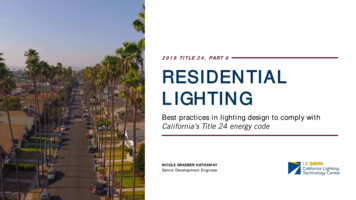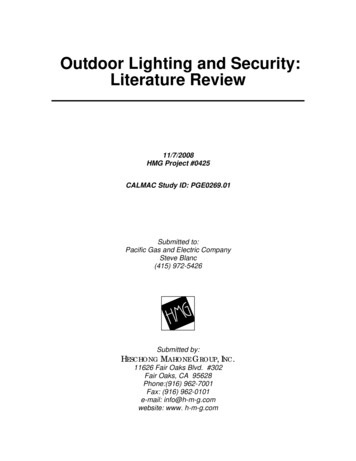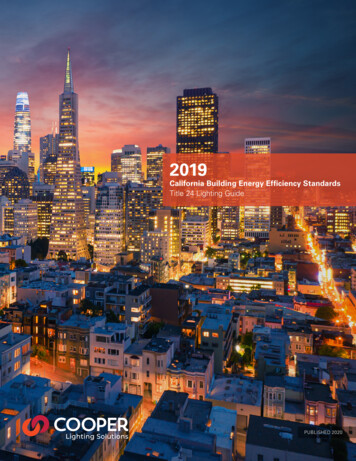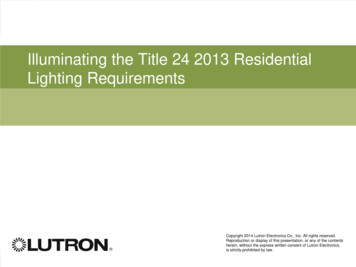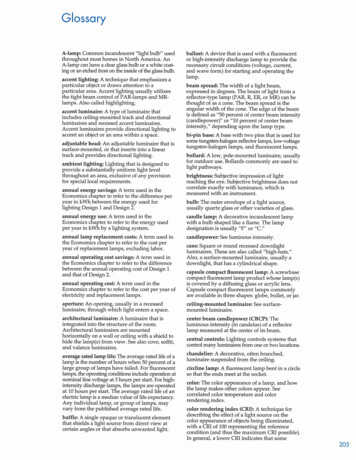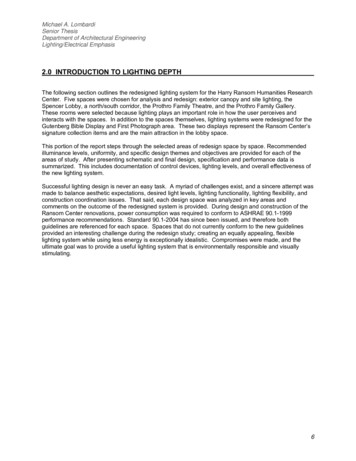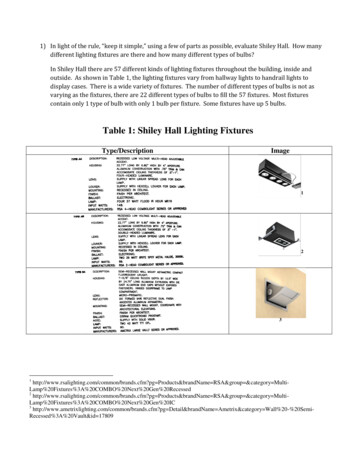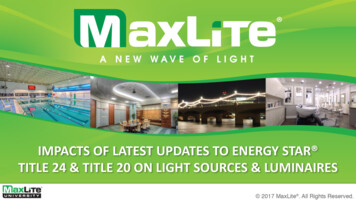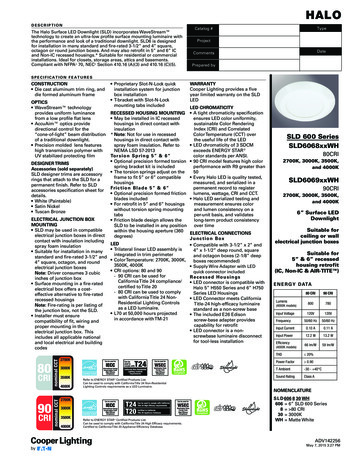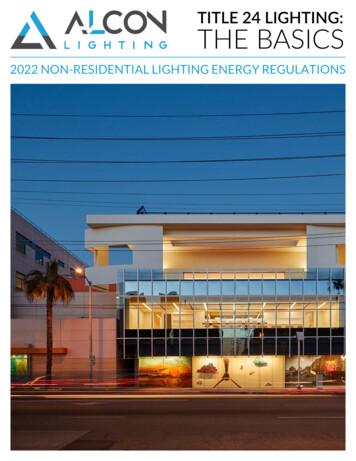
Transcription
TITLE 24 LIGHTING:THE BASICS2022 NON-RESIDENTIAL LIGHTING ENERGY REGULATIONS Hufton & Crow
What is Title 24?Title 24, also known as the California Building Standards Code, sets energy standards for all newresidential and commercial buildings and regulates alterations to existing buildings.Why is it important?Title 24 paves the way for energy conservation in California. This ideally means reduced energy costsand a greener future.As technologies such as LED make headway in residential and commercial lighting, Title 24requirements become more stringent to reflect the increased energy efficiency of available products.At Alcon Lighting, many products comply with Title 24. We can help you pass acceptance tests.Contact us for details.alconlighting.com/blogALCONLIGHTING2
TITLE 24 — KEY CHANGES & TERMSKey ChangesTimeout for occupancy and vacancy sensorschanged from 30 minutes to 20 minutes.Classrooms, conference rooms, offices 250square feet and multipurpose rooms 1,000square feet are now required to have either aVacancy Sensor (automatic OFF, manual ON)or a Partial-ON Occupancy Sensor (automaticOFF, automatic ON to 50-70% of full power). Lower Lighting Power Density allowancesfor many area types. Two new Power Adjustment Factors forinstitutional tuning and daylight harvesting. Three PAF eliminated. Requirements for alterations are now lessstringent.KeywordsLPD — Lighting Power Density. The lighting allowance allotted by Title 24 expressed as watts persquare foot.Why it’s important: The 2016 edition of Title 24 reduced the LPD for many types of spaces andbuildings, making the requirements even tougher than the 2013 edition. Fortunately, LEDs arestill the solution for meeting Title 24 standards.Acceptance Test — An engineering term for “testing to see if the requirements of the code aremet”.Why it’s important: Acceptance testing is a requirement of Title 24.Vacancy Sensor — Lights automatically turn OFF when the room is vacant for 20 minutes orlonger, but only turn on manually.Why it’s important: A vacancy sensor is the most energy-friendly of all sensor options, becauselights will automatically shut off if the room is unoccupied, and will only turn back on againmanually.Occupancy Sensor, Partial-ON — Lights automatically turn OFF when the room is vacant for 20minutes or longer. Lights automatically turn ON to 50-70% when someone enters the room.Why it’s important: Partial-ON is the second most energy friendly of all the sensor options. Lightswill switch ON automatically but not to 100%, with the expectation that most people won’tbother to turn on more lights or adjust the lighting level.alconlighting.com/blogALCONLIGHTING3
TITLE 24 — KEY CHANGES & TERMSOccupancy Sensor, Partial-OFF — Lights automatically dim to 50% or less of full power whenthe space is vacant for 20 minutes or longer. Lights automatically turn ON when someone enters.Why it’s important: Partial-OFF occupancy sensors are required for corridors, stairwells, and otherspaces where full OFF is not feasible.Multi-Level Lighting Controls — Lighting controls that reduce the power going to a lightingsystem in multiple steps—usually means a dimmer.Why it’s important: Multi-level Lighting Controls are required for any enclosed area 100 squarefeet or larger, with a connected lighting load that exceeds 0.5 watts per square foot.Daylighting Controls — Controls that use oneor more photosensors to detect changes in daylight illumination, adjusting the lighting level inresponse.Why it’s important: Daylighting controls are required in daylit zones, as defined by Title 24. Primarydaylit zones must be controlled separately from secondary daylit zones.Local Switch — Manual switch that is easily accessible.Why it’s important: Most spaces require a local switch, although there are exceptions for publicrestrooms, stairwells, and corridors.Automatic Time-Switch Control — Programm-able time clock that turns off lighting when aspace is typically unoccupied.Why it’s important: Meets the requirement for an occupancy/vacancy sensor for some types ofspaces.Area Category Method: Values for LPD in this document are those allotted by the Area CategoryMethod, one of three possible methods for meeting Title 24 requirements.Demand Management: engineering orcontrolling energy demand through variousmethods such as market controls, financialincentives and social, cultural and behavioralchange, often through state-sponsoredprograms and campaigns.Demand Response: a reduction in energydemand intended to reduce peak demandor avoid system emergencies. In this sense,demand response purports to be more efficientthan adding generation capacity to meet peakand occasional demand. Iván Casal Nietoalconlighting.com/blogALCONLIGHTING4
TITLE 24 — KEY CHANGES & TERMSWhat’s new in commercial regulations?(1) More stringent controls on existing building lighting alterations(2) Consolidation of demand response controls and demand management requirements into asingle new section(3) Requirement that all restrooms install occupancy sensor controls(4) LPD requirements are now based on LED lighting“Lighting is one of the biggest changes with non-residential standards,” notes Brian Selby of Sacramento-based Selby Energy. “Rules are more stringent.” Selby detailed updates in commerciallighting regulations, including new lighting power allowances.“Allowed watts per square footage is lower now,” Selby explained. “The lighting power density(LPD) requirements are now based [entirely] on LED, not fluorescent, lighting.”What’s coming in 2020 includes the addition of Group 1 medical facilities to T24 requirements(only Group 1-2) and a new code section grouping all demand responsive controls and demandalconlighting.com/blogALCONLIGHTING5
TITLE 24 — KEY CHANGES & TERMSmanagement requirements. Section 130.1(a) now mandates that a manual area control must bein the same enclosed area unless an exception applies.Restrooms must have occupancy sensors, classroom minimum control steps are relocated to adifferent code table and the Energy Commission added a minimum control step regardless ofluminaire type for library stack aisles, aisle ways and open areas in warehouses, parking garages,parking areas, loading and unloading areas, stairwells and corridors.Look for new exceptions for daylit zones, which the code defines as “areas under skylights thatexisting adjacent structures or natural objects block direct sunlight.[and] [a]reas adjacent to vertical glazing below an overhang that covers the entire width of the vertical glazing.”Retail merchandise sales and wholesale showroom areas now have an exception for Sidelit zones.There’s also a new code section called Controls Interactions, which regulates how controls interact with each other. Under section 130.2, the motion sensor requirement exception changes to40 watts for all luminaires. Motion sensor reduction changes to 50-90 percent and must now beseparately capable of turning a luminaire off.The new energy controls stipulate that: “Automatic scheduling controls (time clock) shall allowscheduling of a minimum of two nighttime periods with Independent lighting levels.”Additionally, code section 130.4 says that health care facilities must comply with OSHPD. AsSelby noted, LPDs are drastically reduced by 40 percent. Three new Lighting Power Adjustmentsinclude Clearstory, Horizontal Slats, Light Shelves (No AT). Section 141 designates three newmethods for determining alteration requirements.alconlighting.com/blogALCONLIGHTING6
TITLE 24 — KEY CHANGES & TERMSCalifornia’s Title 24 2019 mandates are effective on January 1, 2020. Read the completecode here.When asked about how today’s builders, designers and planners may overcome code-related obstacles, Selby said that the biggestchallenge is for smaller projects that don’t necessarily have a designated lighting contractor.“Sometimes, they get to the end of the job and the building inspector asks for a certificate — andno one knows who’s responsible,” he observes.The head of one of the agencies that certifies acceptance test technicians, Michael Scalzo, whoruns the National Lighting Contractors Association of America (NLCAA), said that interpretationand education are the main challenges with Title 24.“There’s a lack of education from the end user to the acceptance tester,” Scalzo noted, “andthere’s misunderstanding. People interpret codes to their advantage. For example, under daylighting controls, there’s an exception that states that if you get below a LPD, you don’t needcontrols—but some interpret that as not needing any control. Then, when the acceptance testercomes out, they run into this problem.”Scalzo observes that end users generally don’t understand government lighting controls.“People want to disconnect [dimming] lighting near a window because they think it’s malfunctioning. Also, people don’t understand the control that automatically shuts off lights. In office areas,lobbies, conference rooms, kitchen areas in office spaces and copy rooms, you have to have acontrolled outlet within six feet of an uncontrolled outlet, so they’ll have a duplex receptaclethat’s activated by a time clock or occupancy sensor. Sensors are allowed to go for 20 minutes.The intent is to save energy. So the computer will stay on but the lights turn off.”Scalzo sees understanding work habits as pivotal. “You walk into your office like you’ve alwaysdone and lights don’t automatically come on—you walk out and lights shut off. You might thinkthe device is broken but this is caused by regulation. So, you might have it replaced. Or you thinkthe device is broken when you walk into your office and lights come on at 50 percent capacity.”The Energy Commission’s founding goal, Scalzo and Selby point out, is to reduce energy. Conservation is the premise of California’s lighting controls. “The [government’s energy] code stateswhat amount of energy is allowable,” Scalzo said. “It’s all about controlling energy based on wattage per square footage.”alconlighting.com/blogALCONLIGHTING7
TITLE 24 — KEY CHANGES & TERMSKey 2019 Energy Code Changes100.00 The addition of Group 1, medical facilities to the T24 requirements (only Group 1-2)an overhang that covers the entire width ofthe vertical glazing.110.9 Code section name change, coversdevices and systems in lieu of Title 20. Addeddevices.Retail merchandise sales and wholesale showroom areas now have an exception for Sidelitzones.110.12 New code section: these changesconsolidate all demand responsive controlsand demand management requirementsthroughout Part 6 into a single new section.130.1(e) Relocated to 110.12130.1(a) The Manual area control must be inthe same enclosed area unless an exceptionapplies.130.1(b) Restrooms and health care are excluded from multilevel lighting requirements.Classroom minimum control steps are relocated to Table 130.1(a)Added minimum control step regardless of luminaire type for library stack aisles, aisle waysand open areas in warehouses, parking garages, parking areas, loading and unloading areas, stairwells and corridors found in 130.1(a)Table.130.1(c) Restrooms shall have occupancy sensors.130.1(d) New exceptions for daylit zones;areas under skylights that existing adjacentstructures or natural objects block direct sunlight. Areas adjacent to vertical glazing belowalconlighting.com/blog130.1(f) New code section: Controls Interactions. Details how controls interact with eachother.130.2 24 motion sensor requirement exception change to 40 watts for all luminaires.Motion sensor reduction change to 50-90percent and separately capable of turningluminaire off.Automatic scheduling controls (time clock)shall allow scheduling of a minimum of twonighttime periods with Independent lightinglevels.130.4 No Acceptance Testing. Health carefacilities must comply with OSHPD.140.6 2019 LPDs drastically reduced by 40percent.Three new Lighting Power Adjustments;Clearstory, Horizontal Slats, Light Shelves (NoAT).141.0 Three new simplified methods for determining Alternation requirementsALCONLIGHTING8
TITLE 24 — COMMERCIALTitle 24Non-ResidentialTABLE 140.6 -C AREA CATEGORY METHOD- LIGHTING POWER DENSITY VALUES (WATTS/FT²)PRIMARY FUNCTION AREAALLOWEDLIGHTINGPOWERDENSITY(W/ft²)3Auditorium Area1.40Auto Repair Area0.9021.7Beauty Salon AreaALLOWED LIGHTINGPOWERDENSITY(W/ft²)PRIMARY FUNCTION AREALibrary AreaLobby AreaReading areas1.13Stack areas1.53Hotel lobby0.95 3Main entry lobby0.95 3Civic Meeting Place Area1.33Classroom, Lecture, Training,Vocational Areas1.25Commercial and Industrial StorageAreas (conditioned and unconditioned)0.60Lounge Area0.903Commercial and Industrial StorageAreas (refrigerated)0.7Malls and Atria0.95 3Convention, Conference, Multipurposeand Meeting Center Areas1.2Corridor, Restroom, Stair, and SupportAreas0.60Dining Area1.0Electrical, Mechanical, TelephoneRooms31.0Exhibit, Museum Areas1.8Financial Transaction AreaGeneralCommercialand IndustrialWork AreasLow bay1.00.9 2High bay1.0Precision1.24alconlighting.com/blog1.26 and 7 250 square feet0.75 250 square feet1.0Parking AreaParking GarageArea2Grocery Sales AreaOffice Area331.2Medical and Clinical Care Area0.55 2Exercise Center, Gymnasium Areas0.70Locker/Dressing Room100.14Dedicated Ramps0.30DaylightAdaptation Zones90.601.5Religious Worship AreaRetail Merchandise Sales, WholesaleShowroom AreasTheater Area1.236 and 7Motion picture0.903Performance1.4ALCON3LIGHTING9
TITLE 24 — COMMERCIALLighting PowerAllowance (W/ft2)Type of Building2019 Assembly0.7 0.7Financial Institution0.65 0.35Grocery Store0.95 0.55Gymnasium0.65NewLibrary0.7 0.5Healthcare0.9NewOffice0.65 0.15Parking Garage0.13 0.07Religious0.7 0.8Restaurant0.7 0.4Retail Store0.9NewSchool0.65 0.3Sports Arena0.75NewMotion Picture Theater0.7 0.6Performing Arts Theater0.8 0.5All Other Buildings0.4 0.1Based on Table 140.6-B in the Energy Standardsalconlighting.com/blogALCONLIGHTING10
V I S I T W W W. A LC O N L I G H T I N G . C O M F O R M O R E I N F O R M AT I O NCALL US: 1 (877) 733-5236E - M A I L : S U P P O RT@ A LC O N L I G H T I N G .C O M2 8 4 5 R O B E R T S O N B LV D . , L O S A N G E L E S , C A 9 0 0 3 4 , U S AThis guide is strictly intended as information about California’s Building Energy Efficiency Standards and should not be used as asubstitute for the energy code. Alcon Lighting strives to present accurate information, though it is not guaranteed. Please consult aprofessional architect, electrician and/or contractor.
Title 24 paves the way for energy conservation in California. This ideally means reduced energy costs and a greener future. As technologies such as LED make headway in residential and commercial lighting, Title 24 requirements become more stringent to reflect the increased energy efficiency of availab
